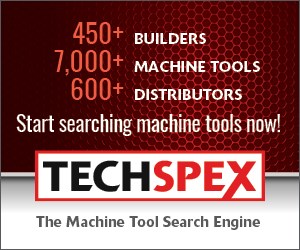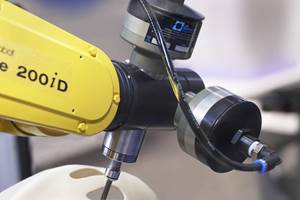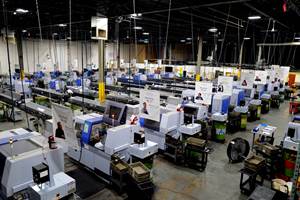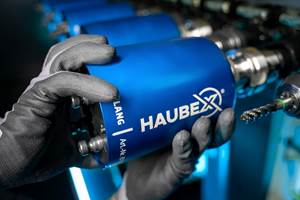Four Questions (& Answers) About Data-Driven Process Improvement at CNC Job Shops
How can shops can make informed decisions using data-driven feedback to improve shopfloor efficiency and profitability? And how will these technologies differ between high- and low-volume production?
Share




The knowledge we accumulate from our daily work must be worth reflecting upon every now and then, right? After all, if it weren’t for the conclusions we draw from our collected experiences, how would we form and test hypotheses or share unsolicited advice at the bar?
This column will offer a bit of both but lean toward the latter.
My colleague Derek Korn and I were recently asked to select a metalworking and machining topic and conduct a live Q&A about it on the main stage at IMTS 2024 this past September. Readers of MMS will remember Derek as a top editor at Modern for many years before taking the helm of Production Machining as its current editor-in-chief, and together he and I chose the topic and title of the IMTS chat: “The Softer Side of Machining: Data-Driven Process Improvement and Digital Innovation.” The discussion focused on how shops can make informed decisions using data-driven feedback to improve shopfloor efficiency and profitability. The key — and in my opinion what made the conversation interesting — was outlining the distinctions between data-driven manufacturing for high- versus low-volume production. Here is a roundup of what I shared during that discussion:
What are the biggest challenges that machine shops face when transitioning to a data-driven approach?
At the ground level, the cultural shift that data-driven transitions represent at “traditional” job shops is real but often misunderstood. If your shop has employees with long-established workflows and a familiarity with manual or semi-automated processes, it is possible that selling data-driven operations to your operators — not to mention management and other shop leaders — could be challenging. But Modern Machine Shop’s reporting has consistently found that resistance to change is far outweighed by the benefits of implementing data-driven processes. And this doesn’t take into account that many employees, especially younger generations, would rather work in tech-forward environments.
Obtaining buy-in from staff during transitions is key. From the minute your shop plans a new data-driven initiative, create a committee or team to help guide the implementation process. There’s a big difference between introducing workflow changes by telling employees, “Here’s how we’re doing things from now on,” versus saying, “Here are the challenges we’re facing. Let’s solve them together.”
Second, the initial investment in equipment for data-driven systems can be intimidating. Software, sensors and sometimes new machinery may be required, and those investments could represent a barrier to entry. My column last month focused on grant opportunities for machine shops, which could be a viable path for capital expenditures in many situations. In addition, representatives from companies that provide data-driven solutions can help you determine the ROI on these investments and help implement them once purchased. The “do-nothing” scenario is also worth consideration: How expensive is it to replace employees who become fed up working at tired shops with outdated technologies?
Finally, there’s the technology learning curve to consider and the issue of “data literacy” among staff. Learning how to collect, analyze and act on shopfloor data is not always an intuitive process, so ensuring your technology providers provide thorough training is key. Data can be used to streamline production and increase revenue, just as it can be misinterpreted and lead to poor decision making.
How can machine shops maintain balance between automated data collection and human expertise?
Data-driven processes and human expertise are not opposing forces. When treated properly, data enhances the decision-making process, rather than replacing it. Real-time shopfloor data for machine utilization, tool life, production bottlenecks and so on require humans to interpret and act upon that data. Ideally, these decision makers will be your experienced machinists and operators who understand the nuances of your machines, cutting tools and general production flow.
Also keep in mind that many data-driven operations such as predictive maintenance and tool-changing schedules can be set up to provide alerts rather than perform an automated procedure — another opportunity for your experienced staffers to evaluate and validate those alerts before acting. Data can be effectively used to inform their decisions, not make them.
How does the role of data differ between high-volume, low-mix production versus high-mix, low-volume shops?
Since consistency and repeatability are key to high-volume production, process optimization should be the goal for these shops. Data-driven strategies can be used to identify and eliminate small inefficiencies that, over time, accumulate and result in lower throughput and lost revenue opportunities. Low-mix, high-volume shops can leverage data to eliminate variability in machining performance in several ways, including identifying optimal predictive maintenance schedules and fine-tuning processes to achieve consistent, repeatable cycle times.
Tech-forward high-mix, low-volume job shops use data very differently. Data can be used to help track tool management and tool wear and to help automate setups for each unique job, or integrated into ERP systems to manage quality, planning, execution and data inspection processes within a single platform — critical when the goal is to achieve success with the first part. Tool Monitoring Adaptive Control (TMAC) systems can use sensor data to monitor tool life and make real-time adjustments, overriding programmed CNC feed rates when necessary to maintain optimal power through each cut. In other words, data-driven production for high-mix, low-volume shops tend to be process specific, with a goal of achieving rapid changeovers and first-part quality.
What emerging data technologies will have the greatest impact on CNC machining over the next few years?
Digital twins, artificial intelligence, mixed/virtual reality for maintenance and training, end-to-end process control and user-friendly dashboards for real-time data analytics are all digital technologies that exist today but are positioned to expand rapidly in the coming years. If you stay tuned, you can read about each of them right here.
Related Content
How to Accelerate Robotic Deburring & Automated Material Removal
Pairing automation with air-driven motors that push cutting tool speeds up to 65,000 RPM with no duty cycle can dramatically improve throughput and improve finishing.
Read MoreInvesting in Automation, Five-Axis to Increase Production Capacity
To meet an increase in demand, this shop invested heavily in automation solutions and five-axis machines to ramp up its production capabilities.
Read MoreInside the Premium Machine Shop Making Fasteners
AMPG can’t help but take risks — its management doesn’t know how to run machines. But these risks have enabled it to become a runaway success in its market.
Read MoreUsing the Toolchanger to Automate Production
Taking advantage of a feature that’s already on the machine tool, Lang’s Haubex system uses the toolchanger to move and store parts, making it an easy-to-use and cost-effective automation solution.
Read MoreRead Next
2025 Top Shops Benchmarking Survey Now Open Through April 30
Modern Machine Shop's Top Shops Benchmarking Survey is now open, offering metalworking and machining operations actionable feedback across several shopfloor and business metrics.
Read MoreSetting Up the Building Blocks for a Digital Factory
Woodward Inc. spent over a year developing an API to connect machines to its digital factory. Caron Engineering’s MiConnect has cut most of this process while also granting the shop greater access to machine information.
Read MoreShop Tour Video: You've Never Seen a Manufacturing Facility Like This
In the latest installment of our “View From My Shop” series, explore Marathon Precision’s multi-process approach to manufacturing, where blacksmiths and hand-forged dies meet state-of-the-art CNC machining. Discover how restoring classic muscle cars and building custom art projects creates a dynamic shop culture — and draws top talent to this unique and innovative metalworking facility.
Read More

















.jpg;maxWidth=300;quality=90)













